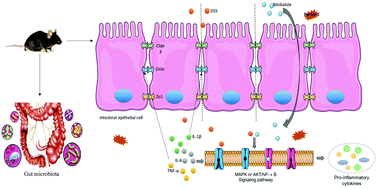The alleviating effect and mechanism of Bilobalide on ulcerative colitis
Abstract
Dysfunction of the intestinal epithelial barrier and intestinal microbiota dysbiosis can drive the onset or aggravation of ulcerative colitis (UC). Bilobalide (BI) is an extract of Ginkgo biloba that has been shown to exhibit a range of anti-inflammatory properties. Herein, we explored functional and mechanistic effects of BI treatment in a rodent model of DSS-induced UC. These analyses revealed that BI treatment was sufficient to reduce disease severity, increase colon length, and normalize colon histological characteristics relative to those observed in DSS-treated model mice. BI also enhanced the expression of tight junction proteins associated with intestinal barrier integrity including ZO-1, Occludin, and Claudin-3. Through 16S rDNA sequencing analyses, BI was also found to influence the overall richness of the intestinal microbiome, promoting the proliferation of probiotic species including Lactobacillus. Consistent with these in vivo findings, BI treatment protected RAW264.7 cells against lipopolysaccharide (LPS)-induced inflammatory damage, suppressing the activation of the AKT/NF-κB p65 and MAPK signaling pathways in this experimental context. In summary, these findings revealed that BI can suppress MAPK and AKT/NF-κB p65 signaling, thereby suppressing the production of inflammatory cytokines including IL-1β, IL-6, and TNF-α, while additionally alleviating UC severity by facilitating repair of the intestinal epithelial barrier and the remodeling of intestinal microbial communities.



 Please wait while we load your content...
Please wait while we load your content...